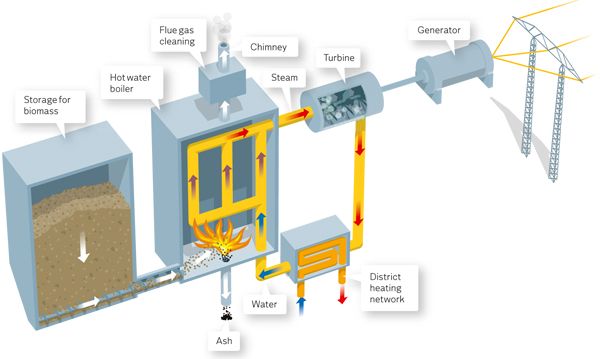What Is Meant By Energy From Biomass?
What is biomass?
Biomass refers to organic materials from plants or animals that can be used as an energy source. The energy is extracted from biomass when the materials are burned directly or converted into fuels such as methane gas, ethanol or biodiesel. Biomass contains stored chemical energy from the sun. Plants absorb sunlight in the process of photosynthesis, which converts the sun’s energy into chemical energy. When biomass is burned, this chemical energy is released as heat.
There are four main categories of biomass:
- Wood and wood waste – Includes forest materials, yard clippings, wood chips, bark, and sawdust
- Agricultural products and waste – Includes crop residues like corn stalks and sugarcane waste, food, vegetable and animal waste
- Municipal solid waste – Includes domestic refuse, paper products, and landfill gas
- Aquatic plants – Includes algae and water hyacinths
Types of Biomass
Biomass refers to organic matter that comes from plants and animals. It represents an abundant renewable energy source that can be utilized for power generation, transportation fuels, and heating. The main types of biomass include:
Plant biomass – This refers to organic matter that originates from plants and trees. Key sources include:
- Wood – One of the most common sources of biomass is wood from forests and timber operations. Wood can be directly burned for heat or converted into wood pellets.
- Agricultural waste – Crop residues like corn stalks, sugarcane bagasse, and rice husks are examples of agricultural biomass wastes that can be used for energy.
- Energy crops – Crops like switchgrass and Miscanthus are specifically grown to serve as biomass feedstocks for generating renewable power and fuels.
Animal biomass – Organic waste matter that comes from animal sources can also be used for energy production. A prime example is manure from livestock operations.
Municipal waste biomass – Biodegradable waste materials from households, businesses and cities can provide a source of biomass. Types include paper, cardboard, food scraps, grass clippings and sewage sludge.
How biomass is used for energy
There are several main ways that biomass is used to generate energy:
Burning biomass directly for heat and electricity – This involves the combustion of raw biomass like wood, agricultural residues, and animal waste to produce heat and/or generate electricity through turbines or steam engines. The heat and power can be used domestically or fed into the electrical grid. Burning biomass directly is a traditional use of bioenergy.

Converting biomass to liquid biofuels like ethanol and biodiesel – Biomass feedstocks like corn, sugarcane, vegetable oils, and crop residues can be processed into liquid fuels like ethanol and biodiesel through fermentation, pressing, and chemical conversion processes. These liquid biofuels can directly replace fossil fuels like gasoline and diesel in vehicles and equipment.
Biomass in biogas digesters – Organic matter like animal manure, food waste, and sewage sludge can be anaerobically digested by bacteria to produce biogas, which is composed of methane and carbon dioxide. Biogas can be used similarly to natural gas for heating, cooking, and generating electricity.
Using biomass directly for energy has the advantage of minimizing conversion steps and costs. However, converting biomass into liquid fuels and biogas enables integration into existing energy infrastructure and use in vehicles and engines designed for liquid and gaseous fuels.
Advantages of biomass energy
One of the key advantages of biomass energy is that it’s renewable and sustainable. Unlike fossil fuels like coal, oil and natural gas which take millions of years to form, biomass can be regrown relatively quickly. This means we can produce biomass energy again and again without depleting finite resources.
Using biomass for energy also reduces the amount of waste sent to landfills. Instead of throwing away agricultural or forestry residues, they can be productively used as biomass feedstocks. Diverting this waste for energy avoids methane emissions from landfills and turns trash into treasure.
In addition, biomass energy helps to reduce dependence on fossil fuels. By generating energy from biomass instead of coal, oil or gas, we can work towards a more sustainable energy mix and improve energy security. There’s an abundant supply of biomass worldwide, so it can supplement or replace conventional fuels in many applications.
The development of the biomass industry also promotes rural economic growth through job creation in the agricultural and forestry sectors. Cultivating energy crops or utilizing residues creates economic opportunities for landowners, farmers and rural communities. Biomass energy keeps money circulating regionally rather than exporting it overseas.
Disadvantages of biomass energy
While biomass can provide clean and renewable energy, it also comes with some drawbacks. One major concern is air pollution. Burning biomass releases carbon dioxide, particulate matter, volatile organic compounds, and other emissions that can degrade air quality. Since biomass often contains nitrogen, its combustion also leads to nitrogen oxide emissions, which contribute to smog and acid rain. These air pollutants can cause public health issues if not properly controlled.
The large amount of land and water resources required to grow biomass feedstocks also pose challenges. Vast areas of cropland are needed to produce corn, soy and other crops for biofuels. This can displace food production and contribute to deforestation in some regions. Growing biomass crops also requires substantial amounts of water, which strains freshwater supplies. Competition over land use for food, fuel and carbon sequestration needs careful balancing.
Despite its renewability, biomass energy has higher costs compared to fossil fuels in most cases. The expenses of feedstock harvesting, preprocessing, and transportation drive up the costs of biomass fuels. Converting biomass to usable energy forms like liquid biofuels also requires costly processing facilities. While costs are improving with advancements in conversion technologies, biomass energy often relies on subsidies and incentives to compete with cheaper fossil fuel alternatives.
Biomass Energy Potential
Biomass currently provides about 5% of total primary energy use worldwide. However, biomass has the potential to play a much bigger role in the future global energy mix with the right policies and incentives in place. According to the International Renewable Energy Agency (IRENA), sustainable biomass could supply up to 100 exajoules (EJ) of energy by 2050, representing around one-quarter of projected global primary energy demand.
The regions with the highest potential for growth in biomass energy are Asia, Latin America and Africa. These regions have large agricultural sectors and forests that can provide substantial supplies of biomass feedstocks. Europe also has significant potential for expanded use of biomass, focused mainly on forest resources and agricultural residues. In North America, biomass energy growth will likely center around the forestry and wood products industries.
Key factors that will determine the future growth of biomass energy include: the development of efficient bioenergy conversion technologies; implementation of sustainability practices for feedstock production; and government policies that incentivize bioenergy and put a price on carbon emissions. If these drivers are in place, biomass energy could see rapid growth and make major contributions to climate change mitigation.
Biomass Energy Policies
Many governments have implemented policies to encourage the development and adoption of biomass energy. These policies include financial incentives, mandates, and targets aimed at expanding biomass power capacity and biofuel production.
Financial incentives for biomass energy include tax credits, grants, rebates, and subsidies. For example, the US federal government offers production tax credits for renewable electricity generation from biomass. Many states also have renewable portfolio standards that require utilities to source a certain percentage of electricity from renewables like biomass. The European Union has set targets for member states to source 10% of transportation fuels from renewables like biofuels by 2020.
Governments have also implemented mandates and blending requirements to expand biofuel usage. For instance, the US Renewable Fuel Standard mandates the blending of billions of gallons of biofuels into the fuel supply annually. The EU Fuel Quality Directive sets a greenhouse gas reduction mandate that incentivizes increased biofuel blending. Such policies create guaranteed markets for biofuels.
In summary, biomass energy policies include financial incentives, mandates, and targets aimed at spurring investment, development, and adoption of biomass power and biofuels. These government policies play a key role in supporting the growth of biomass energy worldwide.
Leading countries in biomass energy
Many countries around the world rely on biomass as a significant source of renewable energy. Here are some of the leading countries when it comes to biomass energy production and consumption:
United States
The United States is the world’s largest producer of bioenergy, generating over 60 million tons of oil equivalent from biomass sources in 2020. Wood and wood waste account for about 80% of biomass use, followed by biofuels like ethanol. The U.S. aims to further expand bioenergy production to help meet renewable energy and carbon reduction goals.
Brazil
Brazil comes in second for total biomass energy production, driven heavily by bioethanol production from sugarcane. Around 16% of Brazil’s energy comes from biomass sources. The country plans to increase biomass power generation capacity by 50% by 2030.
Germany
Germany relies on biomass for around 8% of its total primary energy supply. It is Europe’s biggest producer of biomass electricity, utilizing sources like biogas, biodiesel, and waste incineration. Germany aims to increase its bioenergy output to help meet its climate goals and phase out nuclear power.
India
India derives around 25% of its energy from biomass, mostly in the form of traditional uses like cooking and heating. But the country is working to modernize biomass use with waste-to-energy plants, bagasse cogeneration, and biogas systems, with a target of 10 GW of bio power capacity by 2022.
China
China generates over half its renewable energy from biomass, ranking third globally in total bioenergy production. Biomass applications include household biogas digesters, direct combustion, cofiring, and biofuels. China’s five-year plans aim to increase biomass power capacity as part of its clean energy transition.
Major Companies in Biomass Energy
A number of major companies are involved in the biomass energy sector. Here are profiles of some of the key players and their role in the industry:
Drax Group – Drax operates the largest biomass fueled power plant in the world in North Yorkshire, UK. The company converted 4 of its 6 coal-fired generators to run on biomass. It sources millions of tons of wood pellets and other biomass fuels to generate electricity.
Enviva – Enviva is a major wood pellet producer headquartered in Maryland, USA. The company operates pellet mills and export facilities in the southeastern US. Enviva supplies wood pellets to power generators in Europe and Asia.
Pinnacle Renewable Energy – Pinnacle produces wood pellets in facilities across western Canada. The company is a top supplier of wood pellets to Drax and other energy companies in Europe, selling over 2 million metric tons of pellets in 2019.
Vyborgskaya Cellulose – One of the largest wood pellet producers in Russia, Vyborgskaya Cellulose operates four production plants with a total capacity of over 1.1 million tons per year. The company exports biomass fuel to Europe and Asia.
Abellon CleanEnergy – Abellon is an emerging biomass energy company based in India. The company has pellet production plants and biomass power facilities using agriculture waste feedstocks. Abellon supplies biomass fuel domestically and exports to Asian markets.
Future outlook for biomass energy
The future holds both challenges and opportunities for biomass energy. While biomass is currently one of the largest sources of renewable energy, there are concerns about its sustainability and impacts on land use. However, new technological innovations may help address some of these drawbacks.
One major challenge is the limited availability of biomass feedstocks. As demand grows, there could be increasing competition with food production for agricultural residues and crops. Advanced biofuels made from wastes and dedicated energy crops will become more important. More efficient harvesting and utilization of biomass resources will also be needed.
Several new technologies are being developed to improve biomass energy production. For example, thermal, chemical and biochemical conversion processes are being enhanced to be more efficient and cost-competitive with fossil fuels. New types of biomass feedstocks, such as algae, are also being explored.
Genetic engineering of energy crops is another promising approach to increase yields and make biomass crops more robust. Automation and robotics can also optimize biomass harvesting and processing. Digitization and use of big data will allow better management of supply chains and logistics.
With technological progress and responsible policies, biomass can continue to be a sustainable energy source that reduces dependence on fossil fuels. Realizing the full potential of biomass energy while minimizing its limitations will be an important challenge in the coming decades.






